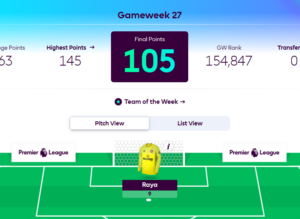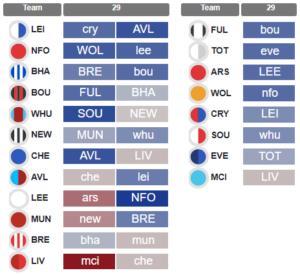Our top team of Pro Pundits and Hall of Famers write about all things Fantasy Premier League (FPL) throughout the season.
Only Premium Members are able to read every single one of these pieces, so sign up today to get full access not just to the editorial content but all of the other benefits, from hundreds of Opta stats to a transfer planner.
Here, former FPL champion Simon March asks if it’s time to think differently about upcoming fixture runs.

Many of us believe that form follows fixtures when it comes to FPL and, thus, it follows that a good run of fixtures signals a good time to invest in a player or team.
Seeking out and exploiting these stretches of matches has been the conventional logic for years but is it really the best approach? Should we be pursuing the reliable returns that we expect from these runs, or are we actually better off chasing bigger singular scores, even if they come at the expense of consistency?
These questions will be the focus of this week’s article.
‘A RUN OF GOOD FIXTURES’

Historically in FPL parlance, a ‘good run of fixtures’ usually refers to around four-to-six consecutive opponents with seemingly low difficulty. This run will appear as a ‘sea of blue’ in the Season Ticker and is gold dust for FPL managers as it hints that our assets will score well for the foreseeable future.
A good run of fixtures might elevate a less-fancied asset, given the even-less-fancied nature of their opposition and it might give us even greater confidence in our big-hitters and captaincy options. This is, for the most part, how most of us usually look at fixtures.
That said, the practice of targeting good fixture runs will inevitably get undermined at several points in a season when the returns don’t reflect expectations. For example, Mohamed Salah (£12.8m) scored 21 points in what was expected to be a difficult fixture for Liverpool at home to Manchester United in Gameweek 26, which was immediately followed by him scoring zero points at Bournemouth. This neatly encapsulates both sides of the coin.
However, following fixtures remains a popular strategy because it offers a level of objective rationale to base decisions on. Aberrations will occur but a match against a team ranked lower in the table will usually offer better opportunities to score than being against a higher team. Therefore, more fixtures versus the former type of team than the latter will increase the expected payoff.
With a consistent run of fixtures broadly considered as the ideal, most fixture tickers, when ordered by difficulty, will place teams with the highest proportion of good (‘blue’) fixtures at the top, inevitably drawing our focus towards them.
In contrast, teams with difficult (‘red’) outings or fixtures that alternate in difficulty will be ranked towards the bottom of the ticker, usually signalling that these teams should be avoided.
THE ‘BIG WINS’ STRATEGY

Yet there are disciplines, tangential to FPL, where a different approach is often adopted. Most top poker players don’t try to win every hand or even every good hand, they instead try to maximise their payoff from only their very best ones.
Similarly, in investing, it is accepted that the majority of a trader’s success will come from a relatively small number of their trades. This is especially the case in early-stage venture capital investing where investors will make, say, ten fairly risky investments with the expectation that maybe one or two will pay off in such a big way that it’ll more than make up for their greater number of failed transactions.
The upshot of this approach is that you can fail, lose and be wrong most of the time yet still succeed. When operating under conditions of uncertainty, such as FPL, an approach based on the acceptance that not everything can be controlled and that mistakes will be made may well be the most pragmatic.
Investing legend Peter Lynch once said of stock picking: “If you’re terrific at this game, you’re right six times out of ten.” George Soros famously made over £1 billion in a single trade shorting the British Pound on ‘Black Wednesday’ in 1992. He stated that: “It doesn’t matter how many times you’re wrong or right but how much money you make when you’re right.”
These perspectives are quite different from how we typically pursue success in FPL. We’ll celebrate the odd 100-pointer when they occur but we wouldn’t see a relatively poor Gameweek as being a necessary step for a better one in future. But, ultimately, if scoring 40 points in one Gameweek helps you score 90 in the next, you’ve still outscored the ‘consistent’ return of getting 60 points both times. Yet most of us optimise toward the latter model.
MAKING BIG BETS IN FPL

So, what might this ‘Big Wins’ approach look like in FPL? First and foremost, it would involve looking at fixture runs differently. Rather than being concerned about the number of ‘red’ matches, we’d focus on targeting the bluest of the ‘blue’, irrespective of how difficult the fixtures immediately surrounding them might be.
Then, to fully embrace this model, we throw everything at those matches. Aim for several assets alongside a captain, irrespective of such tertiary concerns as effective ownership.
The obvious downside to this approach is that putting all our eggs in a few very small baskets places enormous pressure on such fixtures and, if they don’t pay off, we risk torpedoing our season.
Alternatively, the upside is that it can massively pay off and, whilst the approach will still be too risky for some, it’s worth remembering that pursuing a ‘low-risk’ strategy that follows good fixtures can often restrict us.
In a game where it is becoming increasingly difficult to differentiate ourselves from the more informed masses and the template squad, radically rethinking how we look at fixture runs might be a viable route to achieving that goal.
CONCLUSION

My personal philosophy when it comes to FPL is that consistency is the best differential. As much as I enjoy the odd huge score, I also enjoy the grind and can put up with short-term rank stagnation provided that I eventually get to where I want to be by the end of the season. For me, FPL is a challenge of self-discipline as much as anything and I am very much somebody who follows the fixtures.
This consistency-oriented approach tends to be the pervasive model among dedicated managers and is often only departed from when moments of radicalism become necessary. Perhaps they need to make up ground late in the season or, with very little to lose, decide they may as well take some bigger risks.
I know of FPL managers with very different levels of risk tolerance but I can think of few, if any, who follow this high-risk, high-reward approach to fixtures as their core strategy, thus it is difficult to hypothesise exactly how it might play out over a whole season.
The ‘big wins’ strategy is, however, a widely-adopted and often effective strategy in other disciplines such as investing and in poker, where proponents have accepted that failure will occur more often, thus it’s better to focus on maximising the big payoff when wins do happen.
In contrast, much of the conventional FPL strategy is focused on minimising failure, often at the expense of maximising payoffs. That an approach is ‘unusual’ is never reason enough to adopt it – especially when that approach inherently involves high risk – but the growing frustration within the FPL community about how difficult it is to outperform the average means now may be the time to try something different.

